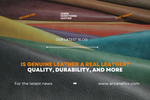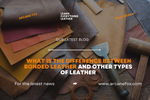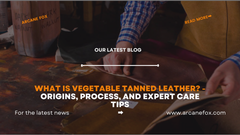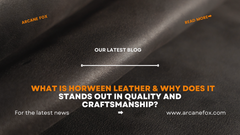The Comprehensive Guide to Split Grain Leather - Definition, Varieties, and More
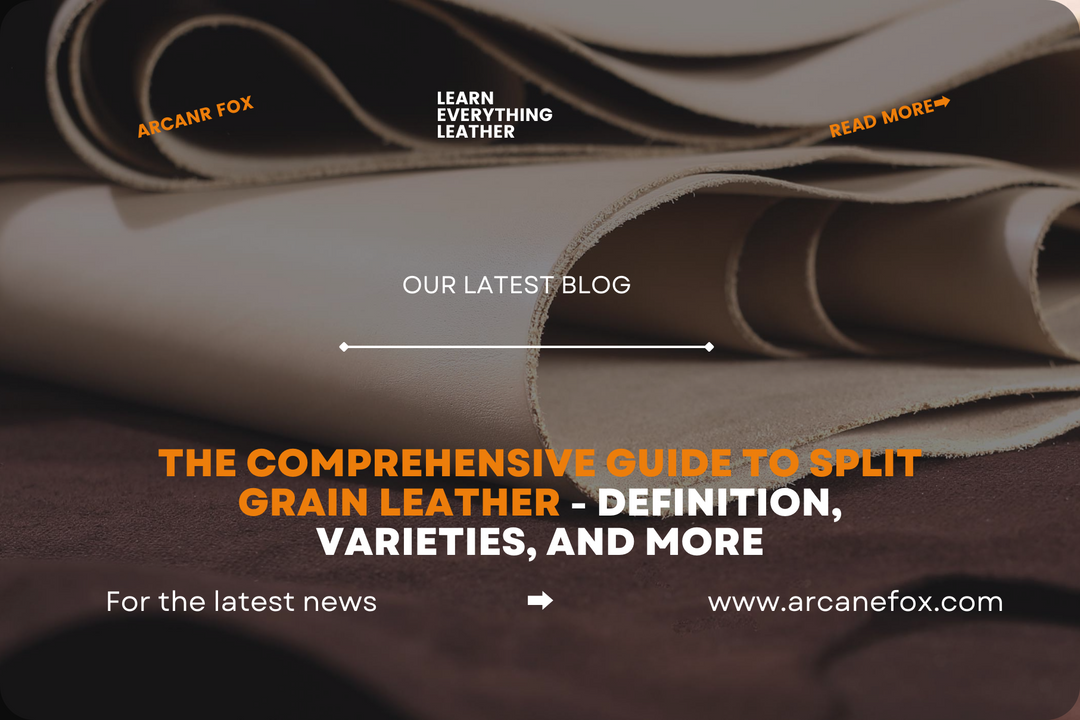
The Comprehensive Guide to Split Grain Leather - Definition, Varieties, and More
Delving into the complex realm of split leather empowers consumers to make informed decisions when choosing leather products. This comprehensive guide illuminates the world of split leather, demystifying its definition, types, production methods, and sustainable alternatives.
1. What is split leather?

Split leather is a form of leather made from the corium, the portion of the animal hide that is left behind after the top grain layer, which contains the coarsest grain, has been removed. This type of leather has particular qualities, such as a fibrous texture and less durability, and is typically more cheap than top grain leather.
Split leather can be further process to create several forms, including suede and bicast leather. Each of which has its own distinct qualities and uses. These forms are frequently use in a variety of products, including affordable furniture, shoes, and accessories.
2. What is Leather Splitting?

Splitting an animal hide into layers creates several grades and varieties of leather, including top grain and split leather. This process is known as leather splitting. The hide is put through a splitter during this procedure, which uses a sizable, razor-sharp blade to cleave the hide into two or more layers. While the remaining corium is use to make split leather, the top layer, or top grain. Often represents the most precious and finest quality part of the hide.
Manufacturers may produce a range of leather varieties with various traits, textures, and features thanks to the leather splitting process. In the leather business, it also aids in maximizing the use of the animal hide and reducing waste.
3. Split Leather VS Leather Splitting
It is important to separate "split leather" from "leather splitting" since these two terms have different meanings in the leather business before one can fully understand the notion of "split leather." It's necessary to look at the definitions and practices related to each phrase in order to distinguish the differences:
4. The history of split leather
Split leather is a term use to describe the separation and thinning of an animal's hide. Because of its gritty texture, this kind of leather is renown for its endurance. Split leather can be produce in a few different methods, but the most common method is by hand splitting with tools. To create this type of leather, the skin of the animal must first be treat with lime or other agents to remove hair. After that, soak it in water to make it flexible and workable. You should stretch the skin out over a bench or another surface, and then make regular horizontal knife cuts (about every 2 inches) until you open the skin into strips.
While controlling the splitting machine, the tanner must take into account the possibility that the skin's density is higher at this point due to the wet skin's higher water content. Due to the water content, wet skin weighs three times as much as dry leather. The presence of water causes the leather to thicken. The tanner must take into account this variation in thickness while configuring the splitting machine in order to achieve the proper leather thickness once the leather has dried.
It is believe that divid grain is more valuable. Something like the grain side, for example, has a fiber structure that is noticeably denser at the top, making it more tear-resistant. The grain split is refer to as smooth leather when it is tanned.
5. What is split leather made from?
Leather that has been split along the center and bonded back together is known as split leather. Splitting leather or split leather are other names for it. Split leather comes in a wide variety of forms and can be produce from the skin of cows, horses, pigs, or sheep. Split leather made from cowhide leather is the most popular type and is typically use for belts and dress shoes. Because it is more flexible than other types of split skins, split sheepskin is frequently use for gloves and slippers.
After leaving the tannery, grain split is no longer use for anything. Then, depending on the sort of leather, the leather seller will employ terms like "soft leather," "alkane leather," and "napa." No longer is the term "split" used to describe the grain side. When the drop split has both a rough and a smooth side, it is only refer to as "split leather," "split," or "suede," not as a "flesh split." Making leathers more intelligible to laypeople requires a differentiation between words used in tanneries and in public. This shows that when we talk about "split," we always mean the bottom, less sturdy layer of things, like the hide.
Unquestionably, top-grain leather has superior qualities that split leather does not. If grain leather is made to look like split leather, the person cannot identify the difference between the two. The leather will then resemble a piece of veneered wood of poorer grade. If the top layer seems like smooth leather, it is not leather; instead, it is a covering, and the grain is create during the embossing process.
Therefore, labeling requirements are appropriate and acceptable, and split leather should be officially and properly stated from the end user's standpoint.
6. Applications for split leather
6.1 Leather clothing

Goat suede and pork split are both widely use in the garment industry. In general, pig leather is stiffer and less rip-resistant than goat suede. Pig leather is therefore primarily use to make inexpensive leather clothing.
6.2 Leather shoes

Due to its breathability, split leather is frequently utilize in the shoe industry for trainers and athletic footwear.
6.3 Furniture leather

Better leather is treat for the contact surfaces (backs, seats, and armrests) of leather furniture in the lower price range. Whereas coated split or fake leather is use for the other surfaces (outsides, backs). Sometimes in the extremely cheap price range, coated split is use to cover the entire piece of furniture. Typically, only "real leather" and related words are use to describe this type of leather. The life expectancy of such furniture is subsequently lower, and in some nations, if this occurs during the guarantee period, a successful claim for reimbursement may be file.
Because of this, you should constantly inquire as to the components that have been process. Unfortunately, especially when buying online, the assertions are frequently incorrect.
6.4 Car leather
Even automakers, both high-end and entry-level, are increasingly using coated or embossed split leather on low contact areas (headrests, door linings) without making the relevant declaration. The consumer pays a significant premium to get a premium "leather interior" or "full leather trim".
Over 10 million steering wheels have been cover with split leather, according to companies who specialize in split leather, even though no manufacturer discloses information on processed split leather in their vehicles. Embossed split leather is also use to cover the interior of the vehicle's doors, seats, and other components.
7. Types of Split Leather

The corium, the lowest stratum of the animal hide left over after the top grain has been remove, is where split leather first appears. There are numerous sorts of leather in this category, each with unique qualities and uses. Here are a few typical varieties of split leather:
7.1 Bicast Leather
Split leather is use to create bicast leather, which is then press onto embossed release paper with a wet polyurethane or vinyl covering and then dried. This procedure gives the leather a grainy texture. Though slightly stiffer than top grain leather, bicast leather has a more uniform texture.
7.2 Suede Leather
The underside of the split grain is use to make suede, which has a soft, napped texture. As the skin of more mature animals might result in a coarse, shaggy nap, it is frequently creat from younger or smaller animals. Because of its softness and distinctive texture, suede is popular because it works well for clothing, shoes, and accessories.
7.3 Genuine Leather
Genuine leather has a wide range of meanings and can apply to several kinds of split leather. The phrase "genuine leather" only refers to the product's presence of leather in some nations. But it frequently means that the leather has undergone substantial processing and might not be of the best caliber. Bicast leather, splits that have been adhere together and colour, or even bonded leather can all be consider genuine leather.
7.4 Bonded Leather
Bonded leather, also referred to as reconstituted leather, is a mixture made from remnants of shredded leather fused with latex or polyurethane on a fiber mesh. The ultimate product's characteristics and quality are affect by the percentage of leather fibers in the blend, which can range from 10% to 90%. Bonded leather is widely use in inexpensive furniture and accessories due to its accessibility.
Numerous objects, including clothing, accessories, furniture, and footwear, have numerous split leather types. Knowing the differences between different leather varieties enables you to choose leather goods with confidence.
7.5 Split Leather vs Genuine Leather
All true leather variants, including top grain, full grain, and split leather, are together refer to as "genuine leather." Split leather is specifically derive from the bottom layers of the animal skin after the top grain or full grain layer has been remove. Although the quality and durability of genuine leather might vary, split leather is typically seen as a less expensive, lower-quality alternative to top grain or other grain leather.
7.6 Is split leather genuine leather?
Split leather is made from the lowest layers of the animal's hide, notably the corium, and is a type of genuine leather. Although it doesn't have the strength and opulence of higher-quality leather varieties, it nonetheless counts as real leather.
7.7 Is split leather better than genuine leather?
As previously established, "genuine leather" is a general phrase that covers anything from split leather to top grain leather. Split leather is thus a variety of genuine leather, and contrasting the two would be to compare a particular item to its more general category.
7.8 Split Leather vs Cow Leather
Although split leather source from cowhides is a member of the cow leather family, it is distinguish from other types by its origin from the lower layers of the hide. Cow leather is a general term for leather derive from cowhides, further classify into types such as full grain, top grain, and split leather.
7.9 Split Leather vs PU Leather
It is a real kind of leather that comes from the lower layer of hides from animals while it is a synthetic material. PU (polyurethane) is an artificial substance creat by covering a fabric base with an emulsion of polyurethane. While split leather has the same characteristics as real leather, the PU offers a more consistent, uniform appearance, and is generally more resistant to stains and water. It also does not have its breathability and durability and the natural, tactile touch of authentic leather.
7.10 Is Split Leather Waterproof?
Split leather is a porous material that can absorb water, hence it is not by nature waterproof. To increase its water resistance, it can be coat with coatings or waterproofing chemicals. Remember that these processes may affect the leather's natural feel and ability to breathe.
7.11 What is split cowhide leather?
A sort of leather that may be split down the middle is called split leather. Splitting leather is the name for this procedure. The ability to be divid in half is where the word "split" originates. It is often produce from cowhide, which is tann before being split in two for used in various crafts.
Split leather was initially develop because it was more economical than entire hides, but due to its great quality and soft texture, it is now largely utilize for crafts and repairs. The most frequent projects that make use of this material are belts, wallets, or jackets.
7.12 What is calf split leather?
The most popular kind of leather use in the clothing business is calf split leather. It's a particular kind of cowhide that has been split down the middle while retaining its natural texture and color. The bottom layer is left untreat, while the upper layer receives a final tan. Split calf leather is less resilient than other varieties of leather (such buffalo or goat), therefore it works best for clothes that won't be in constant touch with harsh surfaces.
7.13 What is split grain leather?
Split leather is different from split-leaf leather in a variety of ways. The term "split grain" in relation to a type of leather as split grain relates to how the animal's skin gets split into two parts when tanning. The skin's outer layer, also known as the "grain side" is more tightly woven than the inside of the skin called "the flesh sides." It is a great option for any leather object like coats, shoes and other items. Contrary to rawhide that hasn't yet been process and split grain leather is able to differentiate itself from the other kinds of leather that are use on items such as animal hide.
8. Embossed split leather

Split leather that has been emboss and cover with a color coating is refer to as "embossed split leather". The split leathers then resemble top grain leather in appearance. Due to split leather's weaker than top grain leather fiber structure, the quality is not as excellent as it may be. Much less tensile strength is present.
9. Split Leather: Properties and Comparisons
We can now appreciate split leather's unique properties and compare it to other leather types after delving into its fundamental aspects. When choosing leather goods made from split leather or other types of leather, buyers can make well-informed decisions by balancing factors including toughness, aesthetics, cost, and ecological effects.
10. How does Split Leather differ from full-grain leather in quality and durability?
Full-grain leather is longer-lasting and is of better standard than split. Split leather is a byproduct of the full-grain production process. The exterior layer of an animal's hide that was not alter after tanning and other procedures for finishing and is then use to create full-grain leather. The expression "Split" refers to the method of removing the outer layer, which is also refer to in the name of grain. The result is that the leather has less durability and is capable of enduring long-term use like its cousin. It is crucial to differentiate between split-leather and split-leather since they are two distinct things.
11. Is split leather good quality?
When compared to top and full grain leather, split leather, which is made from split cowhide, is typically more cheap and has unique qualities such a fibrous texture and less durability. Although not the best, it works well for a variety of inexpensive products.
12. Is split leather any good?
The value of split leather mostly depends on the intended application and personal preferences of the buyer. Split leather can be an affordable substitute for high-end leather for people looking for products like dining room chair seats, leather furniture, recliners, couches, and other items where superior durability might not be a top need.
13. Advantages of split leather
Splitting leather is an excellent technique to recycle used materials while also making financial savings. Additionally, it benefits the environment because fewer trees are cut down and less debris ends up in landfills. Anyone can split leather by themselves using just a few simple tools and materials. It simply takes one person an hour or two to complete the operation.
14. Disadvantages of split leather
Split leather has the significant disadvantage of beginning to dry out and shrink if not treated in a timely manner. The leather may crack as a result, making it very challenging to use split leather. Split leather also has fewer applications than a full piece of leather, which is an issue. Split parts are frequently too small for uses other than trimmings or crafts.
The best quality animal skin should always be purchase as a single piece rather than being divid up before use.
15. Cost of split leather vs. other options
Compared to alternatives like genuine leather, faux leather, or even recycled leather, split leather is far less expensive. The price is around one-fifth of what these other possibilities are! Due to the fact that you are recycling waste materials and lessening your environmental effect, leather splitting is also environmentally friendly.
16. How Split Leather is Made: Production Process Explained?
Split leather items' lifespans can be increase and their environmental impact decreased with proper maintenance and care. To preserve your split leather things in good shape, abide by following rules:
- Clean cautiously: Clean off filth and dust by using a soft, wet cloth. Avoid using harsh cleansers or chemicals that are abrasive since they could damage the surface of the leather. Condition: To keep split leather supple and prevent drying out or cracking. Use a leather conditioner specifically designed for split leather.
- Protect: Consider using a leather product waterproofing spray to prevent water damage. Apply waterproofing solutions sparingly and only when necessary to avoid affecting the leather's natural feel and ability to breathe.
- Store appropriately: Place your split leather products away from harsh light and heat sources in a cool, dry area. Extreme humidity or temperature might cause the leather to dry up, crack, or change color.
- Avoid overburdening: Avoid filling split leather wallets or bags too tightly because this could cause stretching and shape loss. Be careful how much pressure you exert on your leather items because too much pressure might weaken the seams and result in damage.
- Rotate usage: Rotate the use of your split leather items with other products to lessen wear and tear. The leather will have time to rest and repair after being use on a regular basis.
- Repair when needed: For repairs if your split leather item is damaged, see an expert. A product's lifespan can be increase by promptly fixing problems like scratches, tears, and worn seams in order to stop additional damage.
You can keep your split leather products in good condition for as long as possible by adhering to these cleaning and maintenance instructions. Which will also lessen the need for frequent replacement and the environmental impact of your purchases.
17. Our Opinion on Split Leather
In conclusion, split leather is a real leather choice that is both cost-effective and adaptable, with a variety of uses. Customers can choose wisely while shopping for a new collection of leather products to buy by knowing its characteristics, production methods, and how it stacks up against other varieties of leather. Additionally, minimizing the environmental impact of our leather use can be accomplish by taking into account elements like toughness, appearance, cost, and environmental impact. As well as by investigating sustainable alternatives.
Learn more about leather here: Leather 101 - The Ultimate Guide to Different Types of Leather

